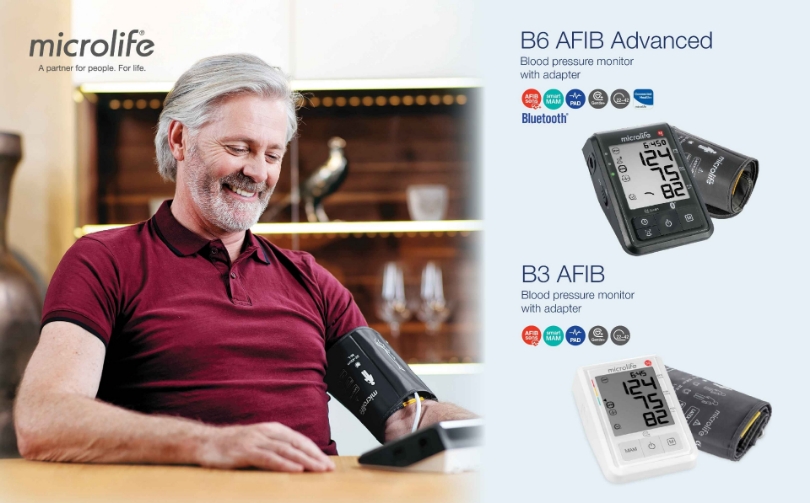Early Stroke Detection With Microlife AFIB Technology

Microlife AFIB presents the most reliable detection of atrial fibrillation during blood pressure measurements.
Atrial Fibrillation (AF) causes high risk of stroke[1].Approximately 40% of AF patients have no symptoms[2]so that many of them are diagnosed by coincidence when hospitalized for other reasons[2], including stroke[3, 4]
What is Atrial Fibrillation (AF)?
In the case of AF, the heart chambers beat chaotically and irregularly. This can cause blood to accumulate in the atria of the heart, clump together, and form blood clots. These blood clots can then migrate through the bloodstream to the brain, where they block the blood vessels and this causes a stroke. The dangerous part of AF is, that about70% of the AF episodes are asymptomatic and remain undiagnosed. In addition, at the beginning AF generally appears only irregularly and can, therefore, be overlooked even during sporadic doctor's visits. Following risk factors can additionally increase the risk of having AF:
• Age
• Hypertension
• Diabetes
• Cardiovascular diseases
• Stress
• Smoking
• Alcohol
• Obesity
How Microlife’s patented AFIB technology Works
Microlife blood pressure monitors with implemented AFIB technology, allow patients to be screened for AF during blood pressure measurements at home, using a sophisticated algorithm. If AF is detected during blood pressure measurements, the AFIB symbol is displayed. Microlife AFIB does not make a diagnosis, but provides important information for your doctor, who can refer you for a 12-lead ECG to confirm the presence of AF.
MAM (Microlife Average Mode) –three automated sequential measurements for the best results
A systematic review of all clinical evidence to the Microlife AFIB detector[9]showed that the highest sensitivity value (97 %) is obtained when three sequential blood pressure measurements were performed with two or three AF positive readings. The highest specificity value(97 %) is obtained with three sequential measurements, of which all three must be AF positive. For this reason the Microlife blood pressure monitors with AFIB technology automatically measure three times.
Irregular heartbeat feature – what is the difference with Microlife AFIB?
“The main purpose of the IHB detector, therefore, is not to diagnose arrhythmias but rather to serve as a warning message indicating that the BP reading may not be accurate because of the presence of arrhythmia.”[5, 6]
The majority of the available blood pressure devices allow blood pressure measurements to be applied simultaneously to irregular heartbeats and arrhythmias. However, this does not distinguish between the different types of arrhythmias. If the IHB / IHD symbol appears in the display, nonhazardous arrhythmias such as sinus arrhythmia, premature atrial contractions (PAC) or bradycardia are also included. This can lead to patient insecurity. Microlife AFIB is the world's only, medically proven technology for blood pressure devices that only detects dangerous atrial fibrillation. The high degree of accuracy has been proven several times in clinical trials and has been recommended by international specialists and physicians
Content and information in this article are provided by Microlife and are for informational purposes only. For any doubts, please consult a healthcare professional.
References
[1] Nichols M TN, Luengo-Fernandez R, Leal J, Gray A, Scarborough P, Rayner M European Cardiovascular Disease Statistics 2012. European Heart Network, Brussels, European Society of
Cardiology, Sophia Antipolis 2012.
[2] Zoni-Berisso M, Lercari F, Carazza T, Domenicucci S: Epidemiology of atrial fi brillation: European perspective. Clin Epidemiol 2014; 6:213-220.
[3] Sanna T, Diener HC, Passman RS, Di Lazzaro V, Bernstein RA, Morillo CA et al.: Cryptogenic stroke and underlying atrial fi brillation. N Engl J Med 2014; 370:2478-2486.
[4] Gladstone DJ, Spring M, Dorian P, Panzov V, Thorpe KE, Hall J et al.: Atrial fi brillation in patients with cryptogenic stroke. N Engl J Med 2014; 370:2467-2477.
[5] Verberk WJ, Omboni S, Kollias A, Stergiou GS: Screening for atrial fi brillation with automated blood pressure measurement: Research evidence and practice recommendations. Int JCardiol
2016; 203:465-473.
[6]Alpert BS, Quinn D, Gallick D: Oscillometric blood pressure: a review for clinicians. J Am Soc Hypertens 2014; 8:930-938.


